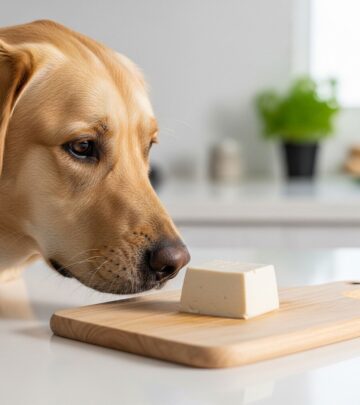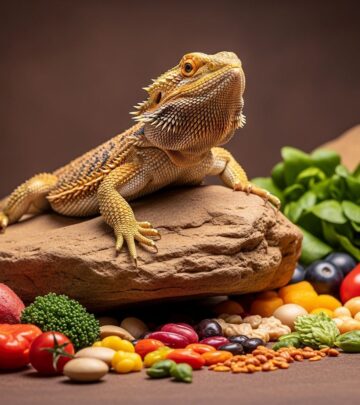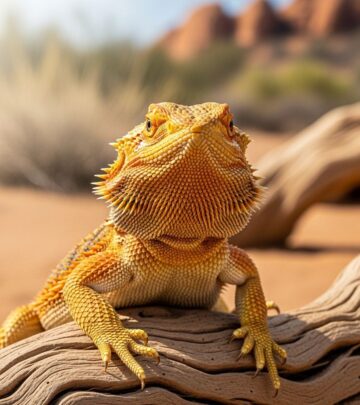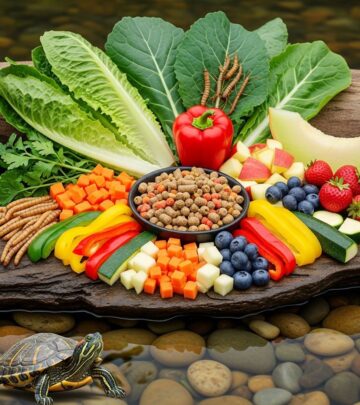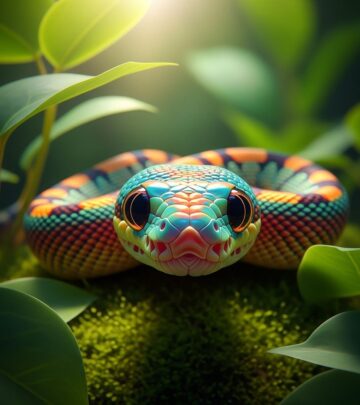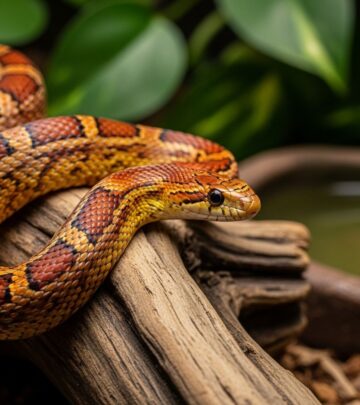Lizard Diet: Complete Guide To Fruits And Vegetables
Essential nutrition guide for providing the right plant-based foods for your lizard's optimal health

Image: HearthJunction Design Team
Understanding Your Lizard’s Dietary Needs
Providing the right nutrition is fundamental to your lizard’s health and longevity. Unlike mammals, lizards have evolved with highly specialized diets that vary significantly between species. Some lizards are strict carnivores, others are herbivores, and many fall somewhere in between as omnivores. Understanding your specific lizard’s natural dietary preferences is the first step in providing proper nutrition.
Lizards can be categorized into three main dietary groups:
- Carnivores: These lizards eat only animal products and require little to no plant matter.
- Herbivores: These species consume primarily or exclusively plant-based foods, including vegetables, fruits, and leafy greens.
- Omnivores: These lizards require a balanced mix of both plant and animal matter for optimal health.
This guide focuses on the plant-based portion of lizard diets, specifically fruits and vegetables that are appropriate for herbivorous and omnivorous species. Knowing which category your pet belongs to is essential for providing the correct balance of nutrients.
Herbivorous Lizards: Diet Essentials
Herbivorous lizards such as Green Iguanas and Spiny-tailed Lizards have specialized digestive systems designed to process plant matter. These species require daily fresh food offerings with the majority of their diet consisting of nutritious leafy greens supplemented with other vegetables. Fruits should be offered in moderation as treats due to their higher sugar content.
Leafy Greens: The Foundation
Leafy greens should make up approximately 70-80% of a herbivorous lizard’s diet. These provide essential vitamins, minerals, and fiber necessary for proper digestion. Top choices include:
- Collard greens
- Mustard greens
- Dandelion greens (pesticide-free)
- Turnip greens
- Kale (in moderation)
- Endive
- Escarole
- Bok choy
It’s important to rotate greens regularly to provide a variety of nutrients and prevent potential toxicity from compounds present in some greens. For instance, while kale is nutritious, it contains goitrogens that can affect thyroid function if fed exclusively or in large amounts.
Vegetables for Herbivorous Lizards
Vegetables should comprise approximately 15-20% of a herbivorous lizard’s diet. They provide additional nutrients, variety, and different textures that encourage natural foraging behaviors. Recommended vegetables include:
- Bell peppers (all colors)
- Shredded sweet potatoes
- Shredded carrots
- Various squash varieties
- Zucchini
- Green beans
- Peas
- Tomatoes (sparingly, as they are acidic)
These vegetables can be fed either raw or cooked, though raw vegetables retain more nutrients. If cooking, steam lightly rather than boiling to preserve nutritional value. Always cut vegetables into appropriately sized pieces based on your lizard’s size to prevent choking hazards.
Fruits for Herbivorous Lizards
Fruits should make up no more than 5-10% of a herbivorous lizard’s diet. While they provide variety and can be excellent sources of vitamins, their high sugar content can lead to obesity and digestive issues if overfed. Appropriate fruits include:
- Kiwi
- Apples (seeds removed)
- Pears
- Bananas (in small amounts)
- Melons (honeydew and cantaloupe)
- Figs
- Papaya
- Berries (strawberries, blueberries, raspberries)
- Pineapple (occasional treat)
Fruits should be offered as occasional treats rather than daily staples. When feeding fruits, remove all seeds, pits, and rinds as these can be choking hazards or contain compounds toxic to reptiles.
Omnivorous Lizards: Balancing Plant and Animal Matter
Omnivorous lizards, such as Bearded Dragons, many Skinks, and Crested Geckos, require a mix of plant and animal-based foods. The ratio of plant to animal matter often changes as these lizards mature, with juveniles typically requiring more protein for growth while adults need more plant material.
Leafy Greens and Vegetables for Omnivores
Adult omnivorous lizards should receive a daily salad consisting primarily of leafy greens similar to those recommended for herbivorous species. Bearded dragons, for example, thrive on collard greens, dandelion greens, turnip greens, and mustard greens as the base of their diet. Other vegetables can be added for variety and additional nutrients:
- Bell peppers
- Butternut squash
- Acorn squash
- Yellow squash
- Carrots (shredded)
- Green beans
- Peas (removed from pods)
For Blue-Tongued Skinks, the vegetable portion of their diet should focus more on colorful vegetables and less on leafy greens compared to bearded dragons. They particularly benefit from vegetables with high water content to support their hydration needs.
Fruits for Omnivorous Lizards
As with herbivorous species, fruits should be limited to about 10% of an omnivorous lizard’s diet. Crested Geckos are somewhat unique among omnivorous lizards in that they can consume a higher percentage of fruit in their diet, often thriving on commercial diets that contain fruit purees. For most other omnivorous lizards, appropriate fruits include:
- Berries (blueberries, strawberries, raspberries)
- Apple (seeds removed)
- Mango
- Papaya
- Melons
Bearded dragons often have preferences for certain fruits, but these should be offered sparingly as treats rather than dietary staples. Swiss chard, spinach, and beet greens should be limited in omnivorous diets as they contain oxalates that can bind calcium and potentially lead to nutritional deficiencies.
Food Preparation and Feeding Tips
Proper Preparation Methods
How you prepare fruits and vegetables for your lizard can impact their nutritional value and safety. Follow these guidelines for optimal food preparation:
- Wash thoroughly: Always wash all produce carefully to remove pesticides, chemicals, and potential parasites. Using a produce wash or a vinegar solution can help remove surface contaminants.
- Appropriate sizing: Cut food into manageable pieces based on your lizard’s size. For smaller species, finely chopped or grated vegetables are easier to consume.
- Remove inedible parts: Take out seeds, pits, rinds, and tough skins that could be choking hazards or difficult to digest.
- Raw vs. cooked: Most vegetables should be offered raw to preserve nutrients. If cooking, lightly steam rather than boiling to retain nutritional value.
- Variety is key: Mix different vegetables and greens to provide a range of nutrients and prevent potential toxicity from compounds present in some plants.
Feeding Schedule and Portions
Establishing a consistent feeding schedule helps maintain your lizard’s digestive health and overall wellbeing:
- Herbivorous lizards: Offer fresh salads daily, removing uneaten portions after 24 hours to prevent spoilage.
- Omnivorous lizards: Provide fresh plant matter daily, with insects or other animal protein offered several times per week according to species-specific requirements.
- Juvenile lizards: Generally require more frequent feeding than adults, with many species needing daily food offerings.
The appropriate portion size depends on your lizard’s species, size, age, and activity level. As a general guideline, offer an amount of food approximately equal to the size of your lizard’s head for each feeding, adjusting based on appetite and body condition.
Foods to Avoid
While many fruits and vegetables are beneficial for lizards, some can be harmful and should be avoided. These include:
- High-oxalate greens: Spinach, beet greens, and Swiss chard contain oxalates that can bind calcium when fed frequently, potentially leading to metabolic bone disease. These should be offered only occasionally, if at all.
- Avocado: Contains persin, which can be toxic to many reptiles.
- Rhubarb: Contains high levels of oxalates and can be toxic.
- Citrus fruits: Often too acidic for lizards’ digestive systems.
- Iceberg lettuce: Provides very little nutritional value and can cause diarrhea.
- Onions and garlic: Contains compounds that can be toxic to reptiles.
Always research any new food item before introducing it to your lizard’s diet, as nutritional needs vary significantly between species.
Nutritional Supplements
Even with a varied diet of fruits and vegetables, many captive lizards benefit from nutritional supplements to ensure they receive adequate calcium and vitamins:
- Calcium: Essential for bone health and muscle function. Calcium powder without vitamin D3 should be dusted on food items several times weekly for lizards with adequate UVB exposure.
- Calcium with D3: For lizards with limited UVB exposure, calcium with vitamin D3 helps with calcium absorption but should be used less frequently to prevent toxicity.
- Multivitamins: Provide additional vitamins and minerals that may be lacking in captive diets. These should be used sparingly, typically once weekly.
The frequency of supplementation varies by species, age, and reproductive status. Juveniles and breeding females often require more frequent calcium supplementation than adult males.
Signs of Nutritional Problems
Improper diet can lead to various health issues in lizards. Watch for these warning signs that may indicate nutritional deficiencies or imbalances:
- Metabolic bone disease (soft jaw, swollen limbs, tremors)
- Weight loss or failure to gain weight appropriately
- Lethargy or decreased activity
- Abnormal feces (diarrhea, constipation)
- Poor shedding
- Discolored or sunken eyes
If you notice any of these symptoms, consult with a reptile-experienced veterinarian promptly, as early intervention is crucial for successful treatment.
Frequently Asked Questions (FAQs)
Q: How often should I feed my lizard fruits and vegetables?
A: Herbivorous and omnivorous lizards should receive fresh vegetables and leafy greens daily. Fruits should be limited to 1-2 times per week for most species due to their higher sugar content.
Q: Can all lizards eat fruits and vegetables?
A: No, strictly carnivorous lizards like monitors and many geckos cannot properly digest plant matter. Only herbivorous and omnivorous species should receive fruits and vegetables as part of their diet.
Q: Should I peel fruits and vegetables before feeding them to my lizard?
A: For most organic fruits and vegetables, the peel can be left on after thorough washing. However, for heavily waxed produce or items with tough skins, peeling is recommended to improve digestibility.
Q: How do I know if my lizard is getting proper nutrition?
A: A well-nourished lizard will maintain appropriate weight, have clear eyes, smooth skin, proper shedding, and show normal activity levels. Regular veterinary check-ups can help ensure nutritional needs are being met.
Q: Can I use commercial pellets or prepared foods instead of fresh produce?
A: While commercial diets can supplement a lizard’s nutrition, they should not completely replace fresh foods for most species. The exception is certain specialized lizards like crested geckos, which can thrive on high-quality commercial diets formulated specifically for them.
References
- https://www.petmd.com/reptile/care/evr_rp_what-do-lizards-eat%23:~:text=They%2520can%2520have%2520vegetables%2520such,papaya%252C%2520pineapple%252C%2520and%2520berries.
- https://www.ingleside.com/services/other-pets/blog/what-do-lizards-eat-0
- https://www.cedarcreekvet.com/new-patient-center/reptiles—pet-education/reptile-diet.html
- https://vcahospitals.com/know-your-pet/bearded-dragons-feeding
- https://www.chewy.com/education/reptile-and-amphibian/gecko/what-do-lizards-eat
Read full bio of Anjali Sayee






